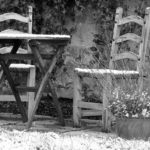Maintaining Decking Over The Winter – The Eco Alternative

Garden maintenance often takes a back seat in the winter. Most people are content to sit in their heated homes and watch the garden get a little overgrown, ready to tame in the warmer months. Unfortunately, decking and similar materials can struggle in the cold – thanks to a combination of rain, snow and ice. However, older, less environmentally-friendly forms of decking may prove more difficult.
Timber Protection
First and foremost, you’ll need to take into account which kind of decking you have. Timber requires different care to composite decking, for example. For a timber deck, you’ll need to apply a new coat of wood stain in November, before winter really takes its toll. To do that, you’ll first need to clean the decking – so dig out the pressure washer (avoid heavy duty washers as they can cause damage), or the brushes, which will get rid of the built-up moss and dirt.
For particularly stubborn marks or dirt, you can use an all-purpose cleaner to get rid of decking. Avoid chlorine-based bleach as this will strip colour from your timber.
Once the decking is clean, you can apply a treatment to protect it from the worst the season has to throw at it. Most people think spring is the best time to apply a stain, but doing it in the winter gives the deck plenty of time to recover from the excess moisture. After applying your stain, avoid walking on the deck for 24 hours at least.
However, a new stain sometimes doesn’t prevent dirt and mould from re-entering your deck. Instead, you’ll want to protect the timber by applying decking oil or a similar sealant such as a varnish. Deck oils improve the structure and strength of the timber, as they penetrate the material and enforce the individual wood fibres.
If the winter proves hard on your decking, you can cover it with a thick protective sheet such as heavy duty plastic to protect it from snow and frost. Don’t leave it on too long, as this will cause excess condensation and increased moisture.
The Green Alternative: Composite Decking
Unlike timber, composite decking is made from 95 per cent recycled materials, and as such is not susceptible to the same organic wear and tear of its wooden counterpart. Examples include Trex composite decking from Arbordeck, which doesn’t rot or split. It also doesn’t need oiling or painting – so all you’ll need to do is sweep and clean down any dirt or mould that begins to grow over the years.
For dirt and debris, just spray with a hose to remove surface debris before scrubbing with warm, soapy water and a brush. Ice and snow should be removed with a plastic shovel or rock salt to help melt ice. If you use a pressure washer, it must be under 3100 psi.
As an eco-friendly alternative to wood, composite decking is also much easier to look after. For people after low-maintenance, low-carbon footprint garden materials, installing composite will save you lots of winter work.
